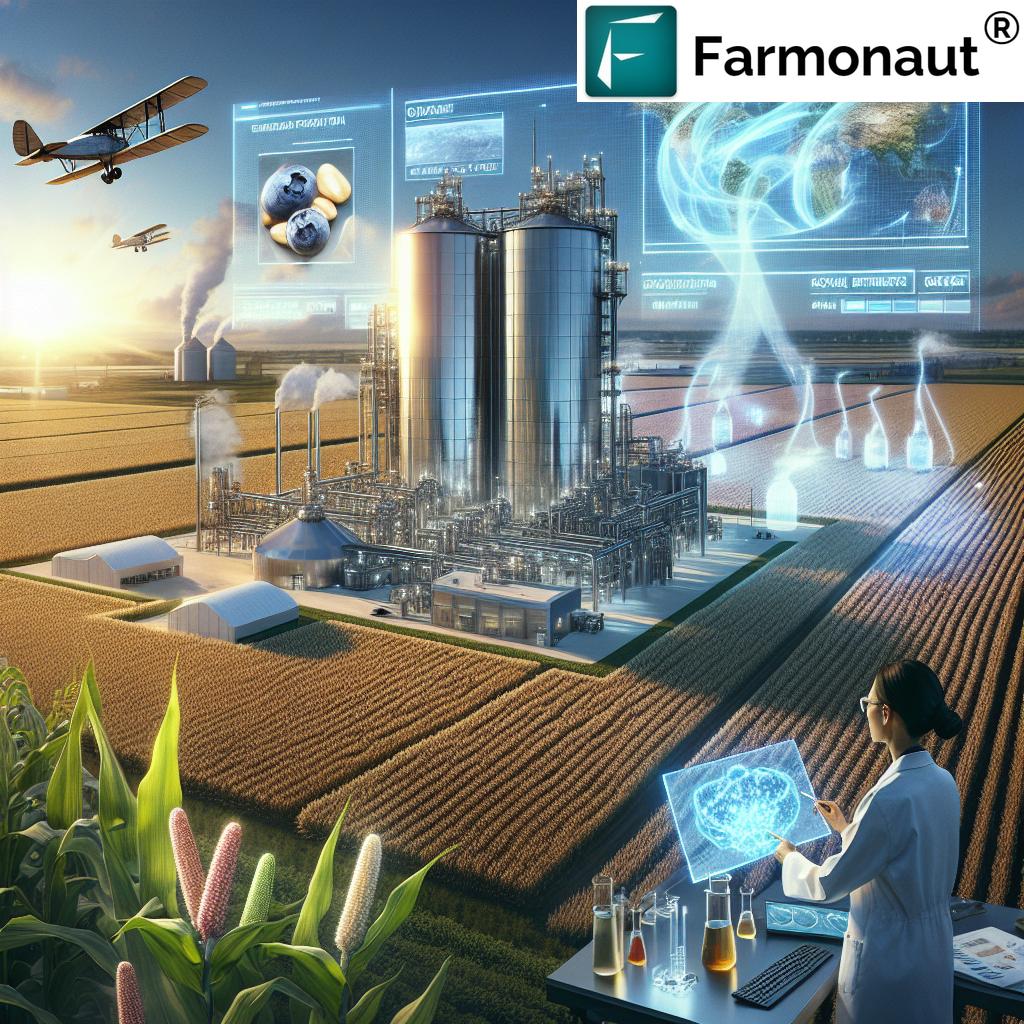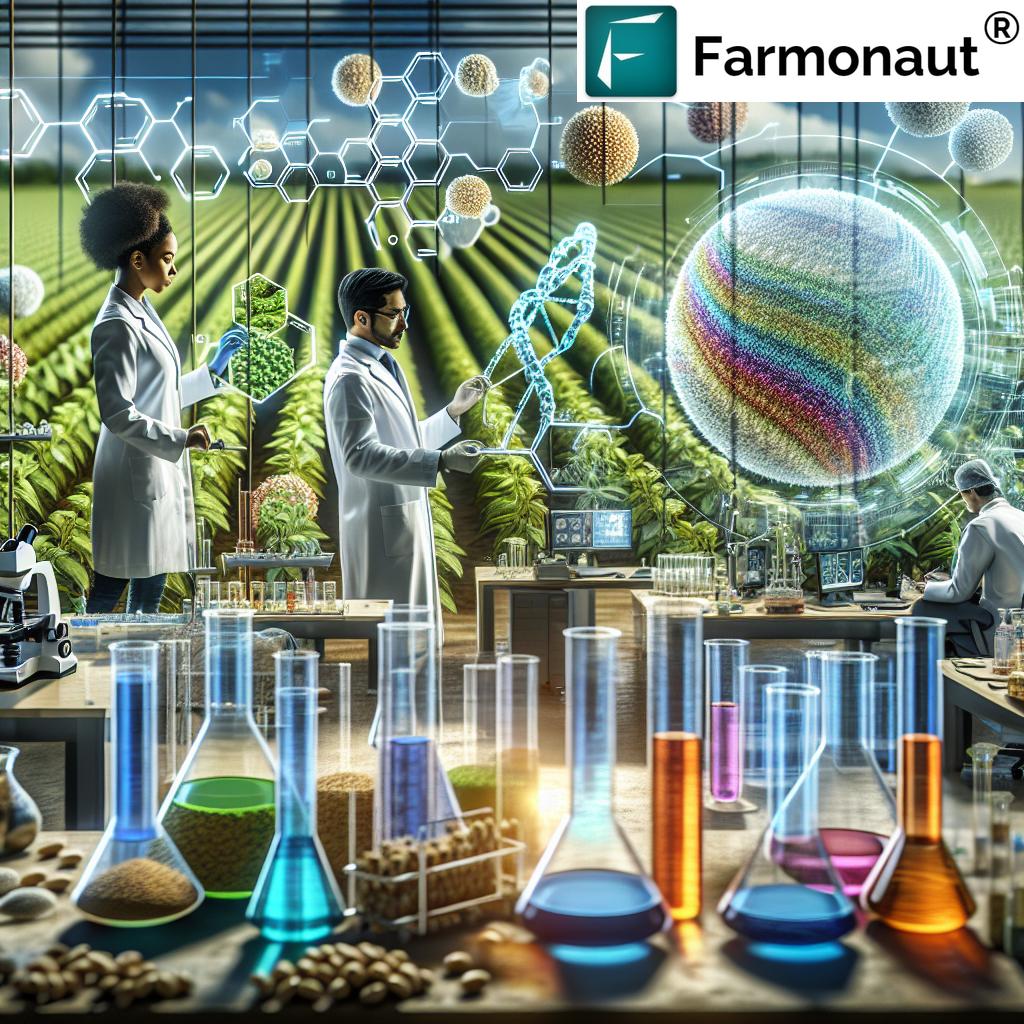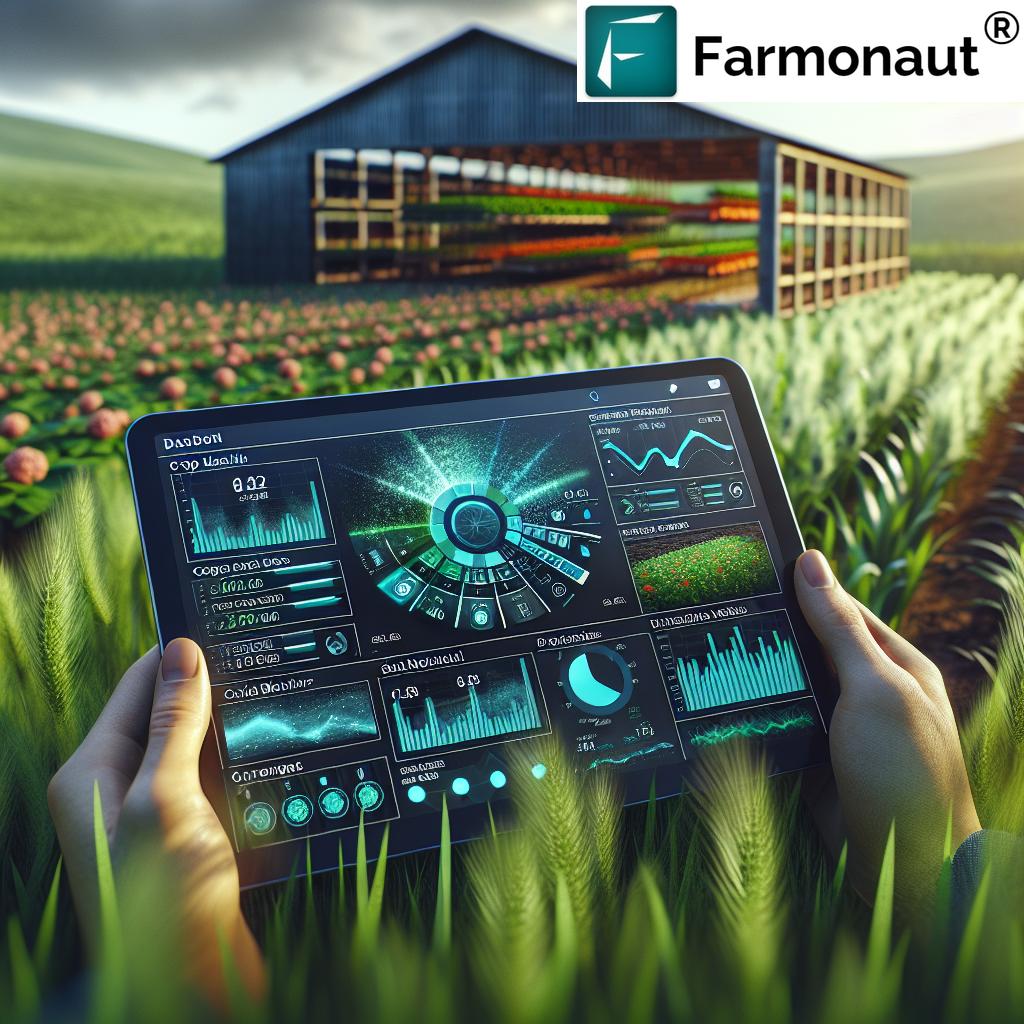Revolutionizing Ohio Agriculture: Farmonaut’s Satellite-Powered Innovations in Biofuel and Crop Management
“Ohio’s ethanol production capacity increased by 35% in 2022, contributing significantly to sustainable biofuel advancements.”
Welcome to a comprehensive exploration of the latest agricultural innovation trends and sustainable biofuel production advancements that are transforming the landscape of Ohio agriculture. In this blog post, we’ll delve into cutting-edge research, groundbreaking technologies, and how the industry is revolutionizing rural development and energy solutions. From satellite imagery enhancing crop management to the health benefits of wild blueberries and soy extract research, we’ll cover a wide range of topics that showcase the incredible progress being made in the field of agriculture.
At Farmonaut, we’re proud to be at the forefront of this agricultural revolution, providing satellite-powered innovations that are changing the way farmers manage their crops and resources. Our mission is to make precision agriculture accessible and affordable to farmers worldwide, and we’re excited to share with you the latest developments in this rapidly evolving industry.
Satellite Imagery in Agriculture: A Game-Changer for Crop Management
One of the most significant advancements in modern agriculture is the use of satellite imagery for crop management. This technology has revolutionized the way farmers monitor and manage their fields, providing unprecedented insights into crop health, soil moisture levels, and overall farm productivity.

At Farmonaut, we harness the power of satellite technology to provide farmers with real-time data on their crops. Our platform uses multispectral satellite images to monitor various aspects of crop health, including:
- Vegetation health (NDVI)
- Soil moisture levels
- Pest and disease detection
- Crop yield prediction
By leveraging this technology, farmers can make informed decisions about irrigation, fertilizer usage, and pest management, ultimately optimizing crop yields and reducing resource wastage. The impact of satellite imagery on agriculture cannot be overstated, as it has led to more efficient farming practices and increased productivity across the board.
Interested in exploring how satellite imagery can revolutionize your farming practices? Check out our web app or download our mobile apps:
Sustainable Biofuel Production: Ohio’s Green Energy Revolution
Ohio has been making significant strides in sustainable biofuel production, particularly in the ethanol industry. The state’s commitment to renewable energy sources has led to a substantial increase in ethanol production capacity, contributing to both economic growth and environmental sustainability.
Key developments in Ohio’s biofuel sector include:
- Increased ethanol production capacity
- Advancements in corn-based ethanol technology
- Exploration of alternative feedstocks for biofuel production
- Investment in waste-to-energy solutions
One of the most exciting developments in this area is the emergence of waste-to-energy solutions. For example, an innovative ethanol plant in Ohio has been converting waste liquids into fuel, demonstrating the potential for turning agricultural and industrial waste into valuable energy resources.
Wild Blueberry Health Benefits: Nature’s Superfood
While we focus on technological advancements in agriculture, it’s essential to recognize the incredible health benefits of some of our most beloved crops. Wild blueberries, in particular, have gained attention for their impressive nutritional profile and potential health benefits.
Research has shown that wild blueberries offer numerous health advantages, including:
- High antioxidant content
- Potential cancer-fighting properties
- Improved cognitive function
- Heart health benefits
- Anti-inflammatory effects
These findings highlight the importance of preserving and cultivating wild blueberry populations, as they represent a valuable resource for both nutrition and potential medical applications.
Soy Extract Health Research: Unlocking the Potential of Soybeans
Soybeans have long been a staple crop in Ohio and many other agricultural regions. Recent research into soy extract has revealed promising health benefits, adding value to this versatile crop beyond its traditional uses.
Some of the key areas of soy extract health research include:
- Potential cancer-preventive properties
- Cardiovascular health benefits
- Bone health and osteoporosis prevention
- Menopausal symptom relief
These findings not only underscore the importance of soybean cultivation but also open up new avenues for value-added products in the agricultural industry.
“Satellite imagery in agriculture has improved crop yield predictions by up to 25% in Ohio’s corn and soybean fields.”
Bio-based Polymers in Agriculture: A Sustainable Alternative
The agricultural industry is increasingly turning to bio-based polymers as a sustainable alternative to traditional plastics. These innovative materials, derived from renewable resources, are finding applications in various aspects of farming and agricultural equipment.

Some of the exciting applications of bio-based polymers in agriculture include:
- Biodegradable mulch films
- Eco-friendly packaging for agricultural products
- Sustainable components for farming equipment
- Controlled-release fertilizers and pesticides
One particularly promising development is the use of soybean-based polyurethane in various agricultural applications. This innovative material offers a more sustainable alternative to petroleum-based plastics while maintaining the necessary durability and performance for agricultural use.
Fertility-related Vitamins: Boosting Crop Health and Yield
Understanding the role of fertility-related vitamins in plant growth has led to significant advancements in crop management and yield optimization. These essential nutrients play a crucial role in various aspects of plant development and reproduction.
Key fertility-related vitamins and their impact on plant growth include:
- Vitamin B1 (Thiamine): Promotes root development and stress tolerance
- Vitamin B9 (Folic Acid): Essential for cell division and DNA synthesis
- Vitamin C: Enhances stress resistance and promotes overall plant health
- Vitamin E: Protects plant cells from oxidative stress
By incorporating these vitamins into fertilizer formulations and crop management strategies, farmers can potentially improve plant health, increase crop yields, and enhance the overall quality of their produce.
Farmonaut’s Role in Agricultural Innovation
At Farmonaut, we’re committed to driving agricultural innovation through our satellite-powered solutions. Our platform combines advanced satellite imagery with artificial intelligence and machine learning to provide farmers with actionable insights and tools for precision agriculture.
Some of the key features of our platform include:
- Real-time crop health monitoring
- AI-based advisory systems
- Blockchain-based traceability
- Resource management tools
- Carbon footprint tracking
By making these advanced technologies accessible and affordable, we’re helping farmers of all sizes improve their productivity, reduce costs, and adopt more sustainable farming practices.
Interested in leveraging our satellite data for your agricultural applications? Check out our API and API Developer Docs.
The Future of Agriculture: Innovations on the Horizon
As we look to the future, several emerging technologies and trends are poised to further revolutionize the agricultural industry. These innovations promise to address some of the most pressing challenges facing farmers and food producers worldwide.
Some of the most promising areas of future agricultural innovation include:
- Gene editing for crop improvement
- Vertical farming and urban agriculture
- Autonomous farming equipment
- Blockchain technology for supply chain transparency
- Artificial intelligence in pest and disease management
These advancements, combined with ongoing research in areas such as biofuel production and sustainable farming practices, are set to transform the agricultural landscape in Ohio and beyond.
Agricultural Innovations and Their Impact
| Innovation | Application | Benefits | Estimated Impact |
|---|---|---|---|
| Satellite Imagery | Crop health monitoring, yield prediction | Improved decision-making, resource optimization | 25% increase in crop yield predictions |
| Sustainable Biofuel Production | Ethanol production, waste-to-energy solutions | Reduced carbon emissions, energy independence | 35% increase in ethanol production capacity |
| Bio-based Polymers | Agricultural equipment, packaging | Reduced environmental impact, sustainability | 20% reduction in plastic waste from agriculture |
| Fertility-related Vitamins | Crop nutrition, stress management | Enhanced plant health, increased yields | 15% improvement in crop quality and yield |
Conclusion: Embracing the Agricultural Revolution
As we’ve explored in this blog post, the agricultural industry is undergoing a remarkable transformation, driven by technological innovations, scientific research, and a commitment to sustainability. From satellite-powered crop management to groundbreaking research in biofuels and plant nutrition, these advancements are reshaping the way we approach farming and food production.
At Farmonaut, we’re proud to be part of this agricultural revolution, providing farmers with the tools and insights they need to thrive in an increasingly complex and challenging environment. By embracing these innovations and continuing to invest in research and development, we can create a more sustainable, productive, and resilient agricultural sector that will benefit farmers, consumers, and the planet as a whole.
FAQ Section
Q: How does satellite imagery improve crop management?
A: Satellite imagery provides real-time data on crop health, soil moisture, and other critical factors, allowing farmers to make informed decisions about irrigation, fertilization, and pest management, ultimately leading to improved yields and resource efficiency.
Q: What are the main benefits of sustainable biofuel production?
A: Sustainable biofuel production offers several benefits, including reduced carbon emissions, increased energy independence, and new economic opportunities for rural communities.
Q: How are bio-based polymers being used in agriculture?
A: Bio-based polymers are being used in various agricultural applications, including biodegradable mulch films, eco-friendly packaging, and sustainable components for farming equipment, helping to reduce the industry’s environmental impact.
Q: What role do fertility-related vitamins play in crop health?
A: Fertility-related vitamins are essential for various aspects of plant growth and development, including root development, stress tolerance, and overall plant health. Incorporating these vitamins into crop management strategies can lead to improved yields and crop quality.
Q: How is Farmonaut contributing to agricultural innovation?
A: Farmonaut provides satellite-powered solutions for precision agriculture, offering farmers real-time crop health monitoring, AI-based advisory systems, and resource management tools. Our platform makes advanced agricultural technologies accessible and affordable to farmers of all sizes.















